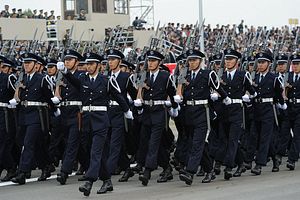The National Institute for Defense Studies, the Japanese Ministry of Defense’s think tank, produced its annual report, the East Asian Strategic Review, for 2015 on April 10. A key theme throughout the analysis (which covers the 2014 calendar year) was the Chinese People’s Liberation Army’s national defense reform and increasing range of exercises.
For example, China and Russia have increased the number of joint military drills in a way that is sparking concern in Tokyo. One such joint exercise involved aircraft identification and air defense, with consideration given to how a crisis situation involving the Chinese Air Defense Identification Zone (ADIZ) over the East China Sea might play out.
Japanese concerns about Chinese behavior in the East China Sea is not just based on conjectures about China’s opaque intentions – there are tangible and direct Chinese actions that Japan finds alarming. On April 15, the Ministry of Defense reported that Japanese Air Self-Defense Force (ASDF) fighters were scrambled 943 times, close to a record, in fiscal year 2014 (April 2014 to March 2015). That’s 133 more times than FY2013, and only second to FY1984 during the Cold War, when ASDF fighters scrambled 944 times.
The bulk of the increase was due to increased Russian activity. In FY2013, Japan scrambled against Russian aircraft 359 times, compared to 473 times in FY2014. The increase in Russian flights near Japan is most likely due to a suspected Russian program to expand its military pilot training. There was also concentrated spike in April of last year following North Korea’s missile launch in late March and the joint U.S.-South Korea military exercises conducted around the same time.
By comparison, Japan scrambled jets against Chinese aircraft 415 times in fiscal 2013 and 464 times in fiscal 2014. China is increasing its military flights between the East China Sea and the Pacific, using the airspace between the islands of Okinawa Prefecture. The Ministry reported that none of the Chinese aircraft – mainly fighter jets approaching the disputed Senkaku/Diaoyu islands in the East China Sea – violated Japanese airspace.
Japan’s defense reforms are largely motivated by a need to respond to an uncertain security environment. Due to increased tensions around the Senkaku/Diaoyu, for example, the Ministry plans to establish an amphibious unit by the end of fiscal 2018. In a step toward this goal, the third round of landing exercises conducted jointly by the Ground and Maritime Self-Defense Forces (GSDF and MSDF, respectively) were held over six days starting on April 11. The two previous exercises were conducted in May and October 2014. The official Japanese government position is that the training exercises are not directed against any country, but meant to improve Japan’s capabilities to defend Japan’s outlying islands overall.
Though the Japanese public remains wedded to the idea of a pacifist Japan that is not a military power, hard facts on the ground may convince them of the necessity of the kinds of reform that Prime Minister Shinzo Abe has been pushing since his re-election. However, persuading the public will require a high level of transparency and robust, open, and honest dialogue.
Even though the Japanese government does deserve high marks for transparency with its annual Ministry of Defense White Papers and the East Asian Strategic Review, the recently enacted state secrecy law has the potential to put a serious dent in this kind of regional confidence building. Furthermore, the Abe government’s low tolerance for dissenting opinions (e.g. the LDP’s questioning of news shows) is counterproductive. Since the Abe government does have logical reasons for its security reforms, it should be more proactive in engaging its own public, thereby helping in order not to raise more concerns in the region. In international politics, the packaging of a policy change – which includes the public, domestic discourse over the new policy – is often just as important as the substance of the change itself.

































